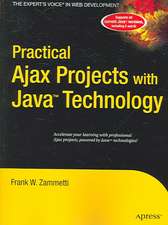Numerical Python: Scientific Computing and Data Science Applications with Numpy, SciPy and Matplotlib
Autor Robert Johanssonen Limba Engleză Paperback – 29 sep 2024
Numerical Python, Third Edition, presents many case study examples of applications in fundamental scientific computing disciplines, as well as in data science and statistics. This fully revised edition, updated for each library's latest version, demonstrates Python's power for rapid development and exploratory computing due to its simple and high-level syntax and many powerful libraries and tools for computation and data analysis.
After reading this book, readers will be familiar with many computing techniques, including array-based and symbolic computing, visualization and numerical file I/O, equation solving, optimization, interpolation and integration, and domain-specific computational problems, such as differential equation solving, data analysis, statistical modeling, and machine learning.
What You'll Learn
- Work with vectors and matrices using NumPy
- Review Symbolic computing with SymPy
- Plot and visualize data with Matplotlib
- Perform data analysis tasks with Pandas and SciPy
- Understand statistical modeling and machine learning with statsmodels and scikit-learn
- Optimize Python code using Numba and Cython
Developers who want to understand how to use Python and its ecosystem of libraries for scientific computing and data analysis.
| Toate formatele și edițiile | Preț | Express |
|---|---|---|
| Paperback (2) | 186.75 lei 3-5 săpt. | |
| Apress – 29 sep 2024 | 186.75 lei 3-5 săpt. | |
| Apress – 25 dec 2018 | 356.23 lei 3-5 săpt. |
Preț: 186.75 lei
Preț vechi: 233.45 lei
-20% Nou
Puncte Express: 280
Preț estimativ în valută:
35.75€ • 38.84$ • 30.05£
35.75€ • 38.84$ • 30.05£
Carte disponibilă
Livrare economică 31 martie-14 aprilie
Preluare comenzi: 021 569.72.76
Specificații
ISBN-13: 9798868804120
Pagini: 690
Ilustrații: X, 690 p.
Dimensiuni: 178 x 254 mm
Greutate: 0.88 kg
Ediția:Third Edition
Editura: Apress
Colecția Apress
Locul publicării:Berkeley, CA, United States
Pagini: 690
Ilustrații: X, 690 p.
Dimensiuni: 178 x 254 mm
Greutate: 0.88 kg
Ediția:Third Edition
Editura: Apress
Colecția Apress
Locul publicării:Berkeley, CA, United States
Cuprins
1. Introduction to Computing with Python.- 2. Vectors, Matrices and Multidimensional Arrays.- 3. Symbolic Computing.- 4. Plotting and Visualization.- 5. Equation Solving.- 6. Optimization.- 7. Interpolation.- 8. Integration.- 9. Ordinary Differential Equations.- 10. Sparse Matrices and Graphs.- 11. Partial Differential Equations.- 12. Data Processing and Analysis.- 13. Statistics.- 14. Statistical Modeling.- 15. Machine Learning.- 16. Bayesian Statistics.- 17. Signal and Image Processing.- 18. Data Input and Output.- 19. Code Optimization.- Appendix.
Notă biografică
Robert Johansson is a numerical Python expert and computational scientist who has worked with SymPy, NumPy, and QuTiP, an open-source Python framework for simulating the dynamics of quantum systems.
Textul de pe ultima copertă
Learn how to leverage the scientific computing and data analysis capabilities of Python, its standard library, and popular open-source numerical Python packages like NumPy, SymPy, SciPy, matplotlib, and more. This book demonstrates how to work with mathematical modeling and solve problems with numerical, symbolic, and visualization techniques. It explores applications in science, engineering, data analytics, and more.
Numerical Python, Third Edition, presents many case study examples of applications in fundamental scientific computing disciplines, as well as in data science and statistics. This fully revised edition, updated for each library's latest version, demonstrates Python's power for rapid development and exploratory computing due to its simple and high-level syntax and many powerful libraries and tools for computation and data analysis.
After reading this book, readers will be familiar with many computing techniques, including array-based and symbolic computing, visualization and numerical file I/O, equation solving, optimization, interpolation and integration, and domain-specific computational problems, such as differential equation solving, data analysis, statistical modeling, and machine learning.
What You'll Learn
Numerical Python, Third Edition, presents many case study examples of applications in fundamental scientific computing disciplines, as well as in data science and statistics. This fully revised edition, updated for each library's latest version, demonstrates Python's power for rapid development and exploratory computing due to its simple and high-level syntax and many powerful libraries and tools for computation and data analysis.
After reading this book, readers will be familiar with many computing techniques, including array-based and symbolic computing, visualization and numerical file I/O, equation solving, optimization, interpolation and integration, and domain-specific computational problems, such as differential equation solving, data analysis, statistical modeling, and machine learning.
What You'll Learn
- Work with vectors and matrices using NumPy
- Review Symbolic computing with SymPy
- Plot and visualize data with Matplotlib
- Perform data analysis tasks with Pandas and SciPy
- Understand statistical modeling and machine learning with statsmodels and scikit-learn
- Optimize Python code using Numba and Cython
Caracteristici
Revised and updated with examples using the numerical and mathematical modules in Python and its standard library Understand open-source numerical Python packages like NumPy, SciPy, SymPy, matplotlib and more Applications include those from science, engineering, data analysis, and big data computing
Recenzii
“I would recommend the textbook to those interested in learning the Python ecosystem for numerical and scientific work. I enjoyed reading the style of examples where a few lines of code are explained at a time. This style feels like I'm getting a personalized lecture from Johansson while reading the book. It will be a very nice resource on the desk of any graduate student working with Python.” (Charles Jekel, SIAM Review, Vol. 62 (2), 2020)
























